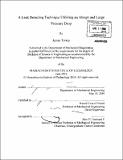A leak detecting technique utilizing an abrupt and large pressure drop
Author(s)
Torres, James, Ph. D. Massachusetts Institute of Technology.
DownloadFull printable version (2.378Mb)
Other Contributors
Massachusetts Institute of Technology. Dept. of Mechanical Engineering.
Advisor
Kamal Youcef-Toumi.
Terms of use
Metadata
Show full item recordAbstract
The distribution of clean, drinkable water is a problem that has been addressed in all civilizations. The most common form of transportation today, is the use of pressurized pipelines to carry the water long distances, but damage to the pipes, such as leaks, can cause considerable losses. The difficulty in detecting these leaks prompted this work, which attempts to find a reliable method of recognizing a leak and suggest possible designs that could be implemented on a pipe-navigating robot. This design would use thin flaps, or "leaves," that would be forced outward by the rapid pressure drop formed in proximity to the leak. In order to determine the characteristic behavior of the system, several simulations, with a circular hole as the leak, were ran that showed that the significant pressure gradient existed only within distance on the order of the diameter of the leak. To validate these results, a high precision pressure sensor was used to try and measure the pressure gradient, but the pressure sensor was too large sense a pressure difference. Therefore, rubber strips were used to emulate the use of "leaves" to perceive the leak. This confirmed the simulation results, as the rubber strips had to be incredibly close to the leak in order to be affected. Furthermore, once the strip was pulled up against the leak, the friction created between the wall and the strip became strong enough that it could be utilized. Both the simulation and experimental results suggest that the leak detecting module should start near the leak. Next, instead of detecting the leak via a motion towards the leak, the module should instead take advantage of the large frictional force that occurs when the leaf has made contact with the leak. Further experiments could include testing the magnitude of the frictional force and creating a prototype.
Description
Thesis (S.B.)--Massachusetts Institute of Technology, Dept. of Mechanical Engineering, 2010. Cataloged from PDF version of thesis. Includes bibliographical references (p. 29).
Date issued
2010Department
Massachusetts Institute of Technology. Department of Mechanical EngineeringPublisher
Massachusetts Institute of Technology
Keywords
Mechanical Engineering.